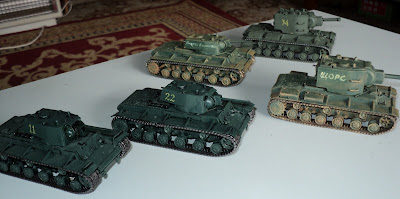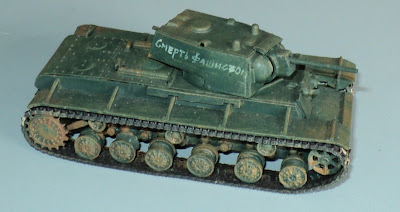.jpg) |
| 1st Guards Mechanised Brigade - veteran of many an action - less its armour and other heavy equipment. The battalions are also shown without their Mortar and Anti-tank Gun Companies. |
One of the attractions of Imagi-Nations is the capacity to create (more or less) historical armies, even use them in familiar environments, but without being too restricted by historical perecedent. In particular, it is hard to refight the entire East Front campaign, especially given the changes in the nature of the respective forces in that war. Given smaller countries, with less than a tithe of the vast prototype armies, gives you the scope for a larger story than can be provided by one-off pick-up and scenario battles.
One of my Imagi-Nation campaigns goes under the 'working title' Latin Wars, a period of warfare among small Latin-American countries that begins towards the end of World War Two. One of these countries, formerly called Vespuccia, has shortly brfore overthrown its Dictator government, substituting for it one with a more societal, though nationalistic, programme Certain political commentators called it Socialist, others even Communist (George Orwell, though sceptical in view of his observations concerning the Stalinist regime in the Soviet Union, was inclined for the time being to scatter praise upon its social ambitions) yet it managed for several years to fly pretty much under the radar of United States's vigilance (paranoia) concerning such regimes. Not that the revivified State hid behind any euphemistic appellation: the Pan-Andean People's Republic was exactly as it announced itself to be.
 |
I Battalion, again.
|
The fact was, this was a populist nation, run by a populist leader, with a populist, and popular, social and economic programme of reform. It quickly became clear, however, that it's popularity did not extend far beyond its borders, barring a few sympathetic commentators. Distracted by the World War and the subsequent falling out with the Soviet Union, the USA was at first, however, inclined let the bordering dictatorship of Orotina to bring down this upstart nation.
 |
| III Battalion. |
The Pan-Andean government found no shortage of volunteers for its armies, as it quickly mobilised several units for the impending war with Orotina (you can see as how this is going to have a distinctly 'Red Army' look, eh?). Not that the latter needed any encouragement from the Great Powers. Expansionist in any case, and casting covetous eyes upon the recently nationalised natural resources President Adolfo-Augusto Ximenez was inclined to the view that by rights the entire nation of The People's Republic was territoryintegral to the Orotinian State, to be brought under proper government (i.e. his) by force.
 |
| Brigade HQ, 1st Guards Mechanised, with the Brigade SMG company and some light trucks. |
Calling themselves the Tigers, the early Pan-Andean units gave a good account of themselves in the early fighting along the border as Orotina tested it's opponent's mettle. Orotinian propaganda expressed contempt for the PAPR Tigers, but this achieved no more than to induce the Pan-Andean volunteers to wear the name with pride. Orotina was to find that, despite its advantages in equipment and training, they were not going to have things all their own way in the wars that followed...
These pictures show the 1st Guards Mechanised Brigade, less its heavy equipment and armour.
 |
| MMG Company with Airfix MMGs. Most of the figures are also Airfix, but the gunner on the right hand one is ESCI |
As these pictures show, some touching up work would not go amiss, it having been eight or nine years since last I painted them and flocked their bases. They have not travelled as well as they might have done, nor have the earthquakes been very kind (several troops got dumped twice from a great height upon the floor).
 |
| Anti-tank Rifle Company, armed with single shot PTRD anti-tank rifles. |
This brigade features also a mix of Airfix, ESCI and HKKO figures. HKKO? Hong Kong Knock-Off. Mostly ESCI in this Brigade. I liked the ESCI rifleman figures, but there were really rather too few of them and too few poses (the standing and kneeling firing are very good). The ESCI MMG is much less crude than the Airfix version, but I much prefer the latter's gunner, sitting behind the weapon. Pity Airfix did not do the same for its Vickers MMG.
 |
| Another pic of III Battalion, 1st Gds Mech Bde. A mix of ESCI and Hong Kong knock-offs. Some of the latter have pins substituting for their SMGs |
 |
| SMG Coy, First Gds Mech Bde. These are Airfix. The rather munted helmet worn by the officer figure probably ought to have something done about it... |
Of course, this is just a small part of the PAPR army. I still have to sort through the Tank Brigade, the three Rifle Brigades, plus assorted security and border companies, and special units that make up the whole force...













.jpg)
.jpg)




